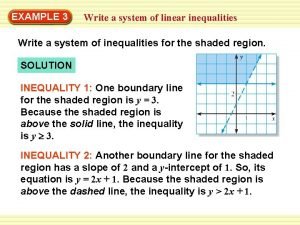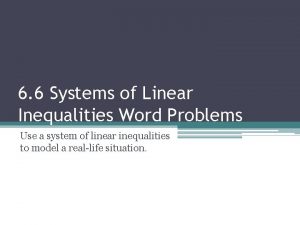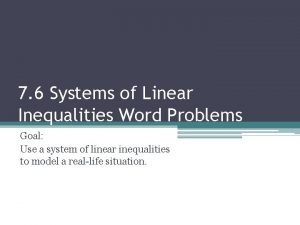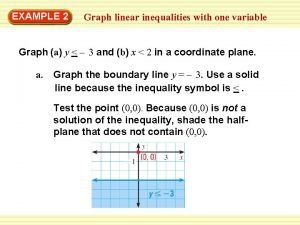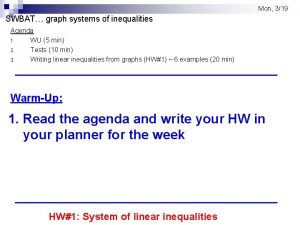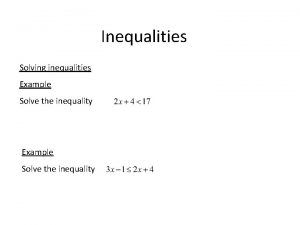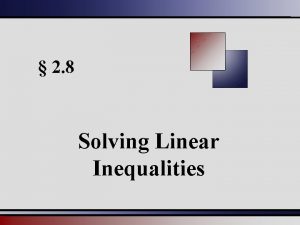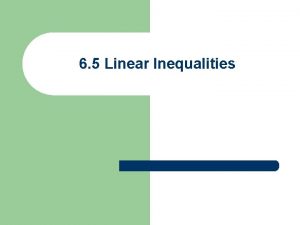EXAMPLE 3 Write a system of linear inequalities








- Slides: 8

EXAMPLE 3 Write a system of linear inequalities Write a system of inequalities for the shaded region. SOLUTION INEQUALITY 1: One boundary line for the shaded region is y = 3. Because the shaded region is above the solid line, the inequality is y 3. INEQUALITY 2: Another boundary line for the shaded region has a slope of 2 and a y-intercept of 1. So, its equation is y = 2 x + 1. Because the shaded region is above the dashed line, the inequality is y > 2 x + 1.

EXAMPLE 3 Write a system of linear inequalities ANSWER The system of inequalities for the shaded region is: y 3 y > 2 x + 1 Inequality 2

EXAMPLE 4 Write and solve a system of linear inequalities BASEBALL The National Collegiate Athletic Association (NCAA) regulates the lengths of aluminum baseball bats used by college baseball teams. The NCAA states that the length (in inches) of the bat minus the weight (in ounces) of the bat cannot exceed 3. Bats can be purchased at lengths from 26 to 34 inches. a. Write and graph a system of linear inequalities that describes the information given above. b. A sporting goods store sells an aluminum bat that is 31 inches long and weighs 25 ounces. Use the graph to determine if this bat can be used by a player on an NCAA team.

EXAMPLE 4 Write and solve a system of linear inequalities SOLUTION a. Let x be the length (in inches) of the bat, and let y be the weight (in ounces) of the bat. From the given information, you can write the following inequalities: x–y 3 The difference of the bat’s length and weight can be at most 3. x ≥ 26 The length of the bat must be at least 26 inches. x ≤ 34 The length of the bat can be at most 34 inches. y≥ 0 The weight of the bat cannot be a negative number. Graph each inequality in the system. Then identify the region that is common to all of the graphs of the inequalities. This region is shaded in the graph shown.

EXAMPLE 4 Write and solve a system of linear inequalities b. Graph the point that represents a bat that is 31 inches long and weighs 25 ounces. ANSWER Because the point falls outside the solution region, the bat cannot be used by a player on an NCAA team.

GUIDED PRACTICE for Examples 3 and 4 Write a system of inequalities that defines the shaded region. 4. ANSWER x ≤ 3, y > 2 x 3 1

GUIDED PRACTICE for Examples 3 and 4 Write a system of inequalities that defines the shaded region. 5. ANSWER y ≤ 4, x < 2

GUIDED PRACTICE for Examples 3 and 4 6. WHAT IF? In Example 4, suppose a Senior League (ages 10– 14) player wants to buy the bat described in part (b). In Senior League, the length (in inches) of the bat minus the weight (in ounces) of the bat cannot exceed 8. Write and graph a system of inequalities to determine whether the described bat can be used by the Senior League player. ANSWER x y ≤ 8, x ≥ 26, x ≤ 34, y ≥ 0 The bat can be used.
 Write a system of linear inequalities
Write a system of linear inequalities System of inequalities examples
System of inequalities examples Graphing linear inequalities word problems
Graphing linear inequalities word problems How to do inequalities word problems
How to do inequalities word problems Systems of linear inequalities word problems worksheet
Systems of linear inequalities word problems worksheet System of linear inequality word problems
System of linear inequality word problems Graphing linear inequalities in one variable
Graphing linear inequalities in one variable Write the system of inequalities
Write the system of inequalities Bounded or unbounded graph
Bounded or unbounded graph
